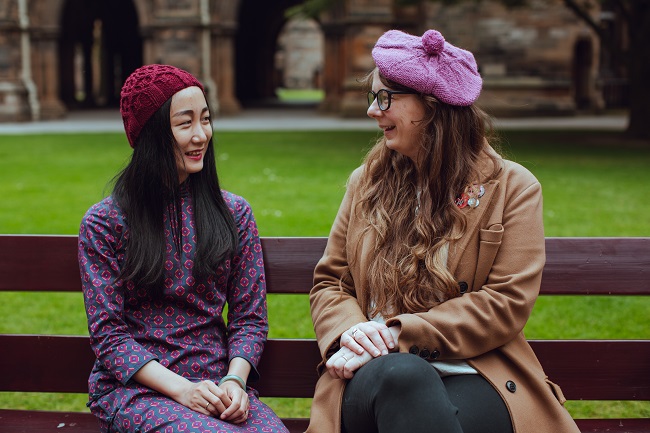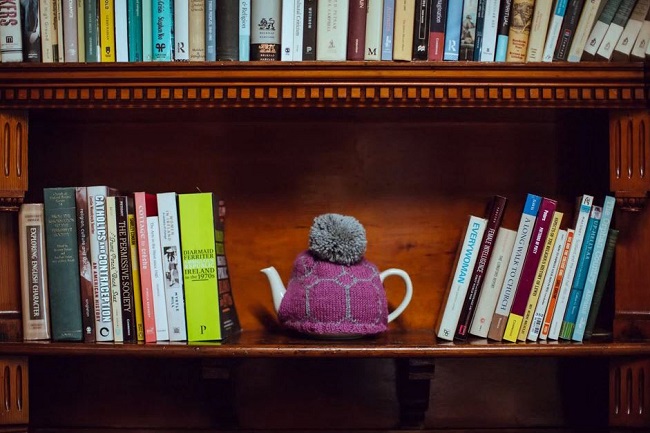University of Glasgow creates knitting patterns based on its iconic architecture
Published: 5 October 2022
The University of Glasgow has launched its own knitting patterns book inspired by its iconic architecture.
The University of Glasgow has launched its own knitting pattern book inspired by its iconic architecture.
Designers from across Scotland contributed their designs for a range of knitted items based on the splendour and beauty of the University’s architecture – from the ornate details in the cornicing and spires to the sweeping arches and grand windows and the modernism of the library.
Now knitters will be able to knit a teapot cosy inspired by the windows on the historic main building or a beanie hat based on the iconic Cloisters arches, or a scarf whose design is based on the University spires that pierce the Glasgow skyline.

Knitting the University of Glasgow book was compiled by Professor Lynn Abrams and Professor Marina Moskowitz – both historians of Scottish knitted textiles – and Christelle Le Riguer, research co-ordinator at the University’s School of Humanities | Sgoil nan Daonnachdan. All three are keen knitters.
The book is the result of a collaboration between historians, the University Archives & Special Collections and a talented band of independent Scottish knitwear designers, including staff and students at the University. It is a part of the Fleece to Fashion project, which is researching the history of knitted textiles in Scotland from around 1780 to the present day. It will be sold through the University’s gift shop.
You can now knit the University of Glasgow! Or rather you can knit patterns inspired by our iconic architecture.
— University of Glasgow (@UofGlasgow) October 5, 2022
The UofG knitting pattern book is part of our @UofGArts @UofGknitting research project on the history of knitted textiles in Scotland. @Lynncabrams explains more pic.twitter.com/PinBrPN1ZU
Professor Abrams of School of Humanities | Sgoil nan Daonnachdan at the University of Glasgow said: “The genesis of this book of knitting patterns, inspired by the built environment of the University of Glasgow, lies in research carried out by historians at the University of Glasgow into the economies and cultures of handknitting in Scotland from the eighteenth century to the present.
“Scotland’s long tradition of knitwear production is rightly celebrated. It feels fitting therefore to celebrate the beauty of the University of Glasgow’s iconic buildings in knitted form. We hope that this book will be as well received by knitters around the world as our own branded wool – Cochno Wool – was when we launched that in 2018.”
Professor Moskowitz of the University of Wisconsin–Madison, USA, said: “Our aim as historians is to investigate the place and significance of hand-knitted textiles to Scotland’s economy and culture, in the past, the present, and the future.
“Studying knitting can be used to think about the role of craft in linking individual creativity to economic pursuits, local design traditions to national heritage, and domestic economies to the creative economy of Scotland. Scotland’s rich heritage of hand-knitted textiles contributes to other national industries, such as tourism and fashion.”
Christelle Le Riguer said: “We hope this book will make its own contribution to help increase public understanding of the ways in which knitting enhances health and wellbeing and cultural enrichment.
“We also hope the patterns will inspire people to visit the University of Glasgow and to knit your own little bit of the university.”

In 2014, the University of Glasgow established the ‘Knitting-in-the-Round’ network which developed collaborations with a range of sectors - business, heritage, education, tourism and culture and arts – and explored the emergence of knitting as the pin-up craft for sustainability, creativity and authenticity.
The University employed a knitter-in-residence, Susan McComb, who took the University architecture as her inspiration to produce some original designs, some of which appear in the new patterns book.
Since then the team of historians have engaged with the University and the wider Scottish knitting community in all sorts of ways, drawing on the enthusiasm, knowledge and expertise of hand knitters to knit all the Commonwealth flags for Glasgow’s Commonwealth Games and to test knit nineteenth century patterns for so-called Shetland lace.
In 2018, the team produced University of Glasgow Cochno knitting yarn. The University’s Cochno Farm has a large sheep flock, primarily to service the needs of veterinary sciences. The fleece from the Scotch Mule sheep was turned into a double-knit worsted yarn and sold through the University gift shop.
A competition amongst staff and students to produce original knitting patterns inspired by the built environment of the University and capable of being knit in our wool elicited designs that reference our gothic architecture and several of those items are included in this collection.
The brief for the new pattern book was to produce an original design for a hand-knitted garment or accessory referencing the built environment of the University. The designers toured the main campus and the archives where they viewed original plans of the University’s Gilmorehill site in the West End of Glasgow. Their designs are inspired by old and new elements of our buildings, from the ‘gothic’ tower and cloisters to the modern perpendicularity of the University Library.
Fleece to Fashion Project
Although knitting is ubiquitous worldwide, it has a distinctive place in Scotland’s landscape, economy, and culture. It has survived modernisation, mechanisation and transformations in global production and trade. Today, the production of knitted textiles makes a vital contribution to the Scottish economy, ranging from wool production to designer fashion. Learn more about the Fleece to Fashion project
Blog: http://knithistory.academicblogs.co.uk/
Twitter @UofGknitting
University of Glasgow's College of Arts Stories From Glasgow podcast episode on the Fleece to Fashion project can be accessed here - Unravelling Scotland's Knit History
The Gilbert Scott Building
The University of Glasgow moved from its historic site off Glasgow’s High Street in 1870, and relocated to Gilmorehill, in the west end of the city.
The Gilbert Scott Building is the University of Glasgow’s striking main building and iconic tower, which stands 278 feet high and is one of Glasgow’s most notable landmarks.
It is named after its architect and designer, Sir George Gilbert Scott. The impressively proportioned building is ornamented in the Gothic Revival style of the 19th century Victorian era. Sir George died before the building was finished, but his son John Oldrid Scott, a famous architect in his own right, completed the building in 1891.
First published: 5 October 2022


